#1780s Italy
Text
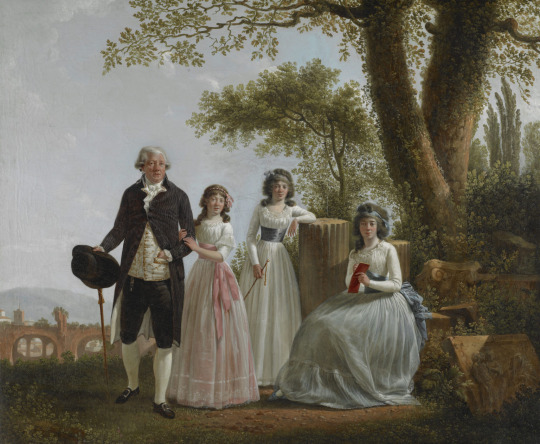
Oil Painting, 1792-1793, Italian.
By Jacques Sablet.
Portraying a man in a grey striped suit and three girls in chemise dresses.
Musée Cantonal des Beaux-Arts Lausanne.
#robe en chemise#Musée Cantonal des Beaux-Arts Lausanne#1780s painting#1780s Italy#1780s#1780s menswear#1780s hair#Jacques Sablet
57 notes
·
View notes
Text




Ancient animals doing animal things.
From: Les antiquités d'Herculanum : avec leurs explications en Franc̦ois. P. Sylvain M. Paris, Chez David, 1780.
DG70.H5 M2 1780
#antiquities#herculaneum#ancient italy#vesuvius#1780#archaeology#French publications#illustration#book illustration#rare books#specialcollections#libraryofva#lion#chicken#bull#cricket#bird
8 notes
·
View notes
Text
in 1883 in the first recorded rodeo takes place in pecos, texas. in 2001 rob smets attends the PBR world finals in jeans and a sports jersey bearing sponsor logos. in 1568 the gelosi acting company coalesces in italy to perform the hot new style of live improv entertainment. in 1780 joseph grimaldi makes his stage debut at 2 years old at london’s famed drury lane. in the many, many years before any white person ever laid eyes on it, a man in what you’d now call northern arizona paints his body in black and white stripes and puts corn husks in his hair. in 1557 ivan the terrible is pallbearer to a man who walked naked in the streets of moscow. in 2017 the ringling bro’s circus announces its last show, 146 years after the titular brothers first formed it. all of these moments (and more!) have lived in my head rolling around like marbles for years now and im so happy to now have the proper method to infect your mind as well:
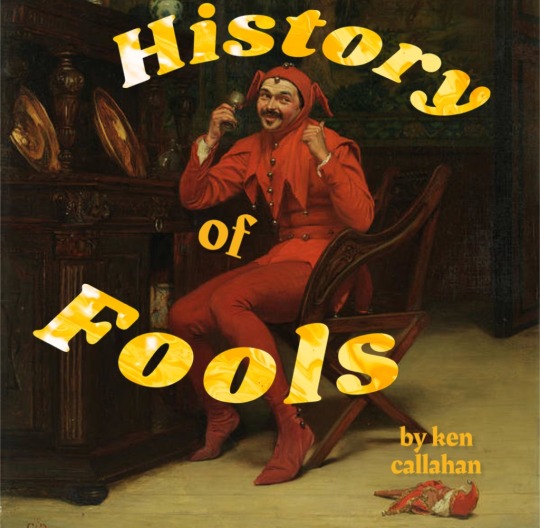
History of Fools is a hobby project of mine i've been working on for over a year now! part essay series, part half-assed podcast, part descent into madness, this little diddy is the culmination of years' worth of highly specific insanity. i have 4 half hour-ish essays/episodes out now reviewing the histories of:
Jesters!
Commedia Dell'arte!
Sacred Clowns and Holy Fools!
and my personal favorite (seriously if you listen to or read any please choose this one) Rodeo Clowns!
I have more episodes planned to get into clowns proper, hoping to come out in 2024. but until then please take a read or a listen and let me know what you think!
CLICK HERE FOR FOOLS!

#a series of essays/audio recordings about niche fool-related history topics. you are interested. reblog#my dear tumblr know it alls pls feel free to correct me on any factual inaccuracies u may find. i welcome them w open arms#and an open email address and open ask box :o)#my website doesn't look the best on mobile but it is functional!#(i posted abt this on twitter abt a month ago and completely forgot to do so here tee hee oopsie)#history#neocities#jesters#clowns#clownblr
125 notes
·
View notes
Text
Oh! the Roast Beef of Old England: Roast Beef, English Nationalism, Effeminacy and Epilepsy (ft. Lord Hervey)
While today if asked what the national dish of England is some might say bangers and mash, Yorkshire pudding or chicken tikka masala in the 18th century the answer was roast beef.
It was roast beef that was the star of the patriotic 18th century song The Roast Beef of Old England. Originally written by Henry Fielding for his play The Grub-Steet Opera (1731) and then reused in Don Quixote in England (1734) the more popular version was written by Richard Leveridge who set it to a catchier tune and added five new stanzas:
When mighty roast Beef was the Englishman's Food,
It ennobled our Veins, and enriched our Blood;
Our Soldiers were brave, and our Courtiers were good.
Oh the roast Beef of old England, and old
English roast Beef.
But since we have learn'd from all-conquering France,
To eat their Ragouts, as well as to dance,
We are fed up with nothing, but vain Complaisance.
Oh the roast Beef, &c.
Our Fathers, of old, were robust, stout, and strong,
And kept open House, with good Chear all Day long,
Which made their plump Tenants rejoice in this Song.
Oh the roast Beef, &c.
But now we are dwindled, to what shall I name,
A sneaking poor Race, half begotten-and tame,
Who sully those Honours, that once shone in Fame.
Oh the roast Beef, &c.
When good Queen Elizabeth sat on the Throne,
E're Coffee, or Tea, and such Slip-Slops were known,
The World was in Terror, if e'er she but frown.
Oh the roast Beef, &c.
In those Days, if Fleets did presume on the Main,
They seldom, or never, return'd back again,
As witness, the vaunting Armada of Spain.
Oh the roast Beef, &c.
Oh then they had Stomachs to eat, and to fight,
And when Wrongs were a cooking, to do themselves right;
But now we're a-I could, but good Night.
Oh the roast Beef, &c.
Leveridge's version espouses the masculine qualities roast beef making Englishmen "brave", "robust," and "strong". Fielding's version from Don Quixote in England contrasts this English masculinity with the non-roast beef eating "effeminate Italy, France, and Spain". (Edgar V. Roberts, Henry Fielding and Richard Leveridge: Authorship of "The Roast Beef of Old England")
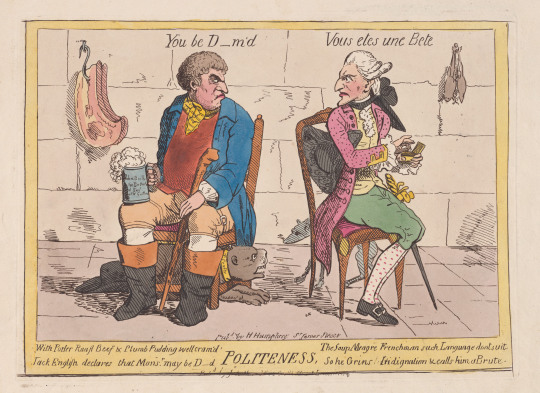
[Politeness, print, after 1780, published by Hannah Humphrey, after John Nixon (1779), via The Metropolitan Museum of Art.]
A common element of English nationalist propaganda was to contrast the masculine beef eating Englishman with the effeminate frogs legs eating Frenchman. The satirical print Politeness compares the masculine John Bull to a stereotypical effeminate Frenchman. John Bull is depicted as a plainly dressed man, holding a pint of beer, with a Bulldog at his feet and a cut of beef hanging behind him. The Frenchman in contrast is depicted as foppishly dressed, holding a snuff-box, with an Italian Greyhound at his feet and a bundle of Frogs hanging behind him. John Bull says "You be D_m'd". The Frenchman responds "Vous ete une Bete". The caption narrates:
With Porter Roast Beef & Plumb Pudding well cram'd, Jack English declares that Monsr may be D------d. The Soup Meagre Frenchman such Language dont suit, So he Grins Indignation & calls him a Brute.
In 18th century English print culture the butcher became somewhat of a stock figure representing English masculinity. There was a series of prints in which a masculine butcher is depicted assaulting a fop. Often with bystanders cheering him on. Some of these prints identified the fop as a Frenchman (such as The Frenchman in London by John Collet and The Frenchman at Market by Adam Smith) but others either don't identify nationality or indicate that the fop is English.

[The Beaux Disaster, print, c. 1747, via The Wellcome Collection.]
The Beaux Disaster depicts the aftermath of an altercation between a butcher and a fop. The butcher has hung the fop up by the back of his breeches on a hook next to cuts of meet. A crowd of passersby point and laugh at the fop, enjoying his misfortune. The caption narrates:
Ye smarts whose merit lies in dress, Take warning by a beaux distress. Whose pigmy size, & ill-tun'd rage Ventured with butchers to engage. But they unus'd affronts to brook Have hung poor Fribble on a hook, While foul disgrace! expos'd in air, The butchers shout and ladies stare. Satyr so strong, ye fops must strike you How can ye think ye fair will like you, Women of sense, in men despise The anticks, they in monkeys prize.
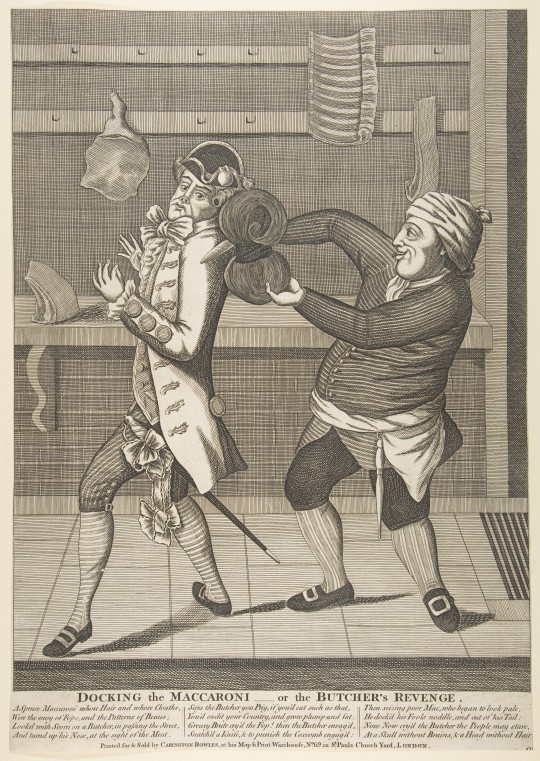
[Docking the Maccaroni–or the Butcher's Revenge, print, c. 1773, published by Carington Bowles, via The Metropolitan Museum of Art.]
Docking the Maccaroni–or the Butcher's Revenge depicts a butcher cutting off a macaroni's queue. Fashionable men in the late 1760s and 1770s would wear elaborate hairstyles sometimes with hair tied back into a 'club'. This hairstyle is a common element of macaroni satire (for a more flattering rendering of the style see George Simon Harcourt by Daniel Gardner). The caption narrates:
A Spruce Maccaroni whose Hair and whose Clothes, Were the envy of Fops, and the Patterns of Beaus; Looked with Scorn on a Butcher; in passing the Street, And turnd up his Nose, at the sight of the Meat. Says the Butcher you Pig, if you'd eat such as that, You'd credit your Country, and grow plump and fat. Greasy Brute cry's the Fop! then the Butcher enrag'd, Snatch'd a Knife, & to punish the Coxcomb engag'd: Then seizing poor Mac, who began to look pale, He docked his Fools noddle, and cut of his Tail: Now Now cry'd the Butcher the People may stare. At a Skull without Brains, & a Head without Hair.
The macaroni was often portrayed as a traitor to English culture not only for his love of french fashion but also his love of Italian pasta. The fabled 'macaroni club' was a reference to Almack's Assembly Rooms at 50 Pall Mall. (see Pretty Gentleman by Peter McNeil p52-55) The Macaroni and Theatrical Magazine (Oct 1772) explains that the origin of the word macaroni comes from:
a compound dish made of vermicelli and other pastes, which unknown in England until then, was imported by our Connoscenti in eating, as an improvement to their subscription at Almack's. In time, the subscribers to those dinners became to be distinguished by the title MACARONIES, and, as the meeting was composed of the younger and gayer part of our nobility and gentry, who, at the same time that they gave into the luxuries of eating, went equally into the extravagancies of dress; the word Macaroni then changed its meaning to that of a person who exceeded the ordinary bounds of fashion; and is now partly used as a term of reproach to all ranks of people, indifferently, who fell into this absurdity.
(Cited in Catalogue of Prints and Drawings in the British Museum edited by Frederic George Stephens and Edward Hawkins, vol.4, p.826)
Foppishly dressed men were blamed not only for the popularisation of pasta in England but also the growing disfavour for roast beef. A letter written to The Connoisseur in 1767 complains:
By Jove it is a shame, a burning shame, to see the honour of England, the glory of our nation, the greatest pillar of like, ROAST BEEF, utterly banished from our tables. This evil, like many others, has been growing upon us by degrees. It was begun by wickedly placing the Beef upon a side-table, and screening it by a parcel of queue-tail'd fellows in laced waistcoats.
(Volume 1, Edition 5)
With both his dress and diet the fop had betrayed English masculinity for French and Italian effeminacy.
Passed down by Lady Louisa Stuart* as an example of the "extreme to which Lord Hervey carried his effeminate nicety", when "asked at dinner whether he would have some beef, he answered, "Beef?— Oh, no!— Faugh! Don't you know I never eat beef, nor horse, nor any of those things?" Stuart was somewhat skeptical of this story wondering "Could any mortal have said this in earnest?"
*anonymously. Stuart wrote the introductory anecdotes included in the 1837 edition of The Letters and Works of Lady Mary Wortley Montagu.
While it's anyone's guess as to whether Hervey said these exact words it is true that he didn't eat beef. Not because he "courted" effeminacy with the "affected and almost finical nicety in his habits and tastes" as John Heneage Jesse suggests (in Memoirs of the Court of England from the Revolution in 1688 to the Death of George the Second) but for his health.
Lord Hailes explained:
Lord Hervey, having felt some attacks of the epilepsy, entered upon and persisted in a very strict regimen, and thus stopt the progress and prevented the effects of that dreadful disease. His daily food was a small quantity of asses milk and a flour biscuit : once a-week he indulged himself with eating an apple : he used emetics daily.
(The Opinions of Sarah Duchess-Dowager of Marlborough edited by Lord Hailes, p43)
Lord Hervey's doctor George Cheyne believed that "a total Milk, and Vegetable Diet, as absolutely necessary for the total Cure of the Epilepsy". (The English Malady, p254)
In An Account of My Own Constitution and Illness Hervey explains that he followed such a diet for three years on Cheyne's prescription eating "neither flesh, fish, nor eggs" but living "entirely upon herbs, roots, pulse, grains, fruits, legumes". (p969) However after three years he reintroduced white meet. He explains his diet in a letter to Cheyne, written on the 9th of December 1732:
To let you know that I continue one of your most pious votaries, and to tell you the method I am in. In the first place, I never take wine nor malt drink, or any liquid but water and milk-tea ; in the next, I eat no meat but the whitest, youngest, and tenderest, nine times in ten nothing but chicken, and never more than the quantity of a small one at a meal. I seldom eat any supper, but if any, nothing absolutely but bread and water ; two days in the week I eat no flesh ; my breakfast is dry biscuit not sweet, and green tea ; I have left off butter as bilious ; I eat no salt, nor any sauce but bread sauce. I take a Scotch pill once a week, and thirty grains of Indian root when my stomach is loaded, my head giddy, and my appetite gone. I have not bragged of the persecutions I suffer in this cause ; but the attacks made upon me by ignorance, impertinence, and gluttony are innumerable and incredible.
Intriguingly in An Account of My Own Constitution and Illness Hervey focuses more attention on colic than epilepsy, dismissing his seizures as rare, but admits he had "two this year". This leads to the impression that his diet was prescribed to treat colic rather than epilepsy and Cheyne did prescribe a milk and vegetable diet in cases of "extreme Nervous Cholicts". (p167) Perhaps it was prescribed to treat both. But why downplay epilepsy in an account of his own illness?
While some enlightenment doctors approached epilepsy with a more scientific approach, superstitions still remained. Some believed epilepsy was a form of lunacy that was controlled by the moon (the word lunatick coming from luna). In An Historical Essay on the State of Physick in the Old and New Testament Dr. Jonathan Harle claimed that "people in this distemper are most afflicted at full or change of the moon." (p124)
Many believed epilepsy was caused by possession and this belief was supported by the bible. Mark 9:17-27, Matthew 17:14-18 and Luke 9:37-43 tell the story of a man who brings his possessed son to Jesus who "rebuked the unclean spirit, and healed the child". The boy's symptoms resemble those of an epileptic seizure and these bible verses are cited by Dr. Jonathan Harle as "an exact description of one that is an epileptick (had the falling sickness) or lunatick". (p124) Harle claimed that was "a truth as plain as words can make it" that some people with epilepsy were "possess'd by the devil". (p22)
Epilepsy was also believed to be caused by sexual depravity. The popular anti-masturbation pamphlet Onania: or, the Heinous Sin of Self-Pollution claimed masturbation caused epilepsy (p23). Onanism: or, a treatise upon the disorders produced by masturbation, or, The dangerous effects of secret and excessive venery claimed that a 14-year-old boy "died of convulsions, and of a kind of epilepsy, the origin of which was solely masturbation". (p19)
With the stigma surrounding epilepsy its no wonder that Hervey kept his seizures secret only telling a select few. One of the people he trusted with this secret was his lover Stephen Fox. Hervey describes having a seizure while at court and keeping it hidden from the Royal Family in a letter to Fox written on the 7th of December 1731:
I have been so very much out of order since I writ last, that going into the Drawing Room before the King, I was taken with one of those disorders with the odious name, that you know happen'd to me once at Lincoln's Inn Fields play-house. I had just warning enough to catch hold of somebody (God knows who) in one side of the lane made for the King to pass through, and stopped till he was gone by. I recovered my senses enough immediately to say, when people came up to me asking what was the matter, that it was a cramp took me suddenly in my leg, and (that cramp excepted) that I was as well as ever I was in my life. I was far from it ; for I saw everything in a mist, was so giddy I could hardly walk, which I said was owing to my cramp not quite gone off. To avoid giving suspicion I stayed and talked with people about ten minutes, and then (the Duke of Grafton being there to light the King) came down to my lodgings, where * * * I am now far from well, but better, and prodigiously pleased, since I was to feel this disorder, that I contrived to do it à l'insu de tout le monde. Mr. Churchill was close by me when it happened, and takes it all for a cramp. The King, Queen, &c. inquired about my cramp this morning, and laughed at it ; I joined in the laugh, said how foolish an accident it was, and so it has passed off ; nobody but Lady Hervey (from whom it was impossible to conceal what followed) knows anything of it.
33 notes
·
View notes
Text
Reales, pieces of eight, doubloones and ducats
Who doesn't know it, in films and books there are always stories about great pirate treasures and lots of coins are shown. But what kind of coins are they? Here is a small overview.
Silver real
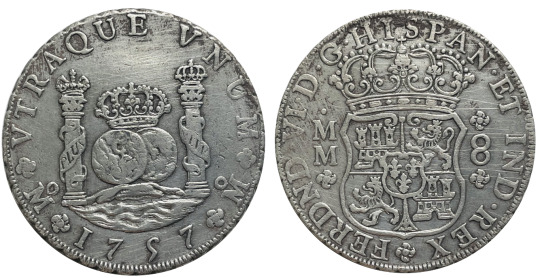
Silver coin: 8 reales Fernando VI, Viceroyalty of New Spain - 1757 (x)
The real was a coin and a currency in Spain for several centuries after the mid-14th century, weighing 0,12 ounces (3,43g) of silver, and these were eight reales to a peso, hence the term " pieces of eight" for pesos.
Silver piece of eight or Spanish Dollar

Spanish piece of eight, 1780 (x)
Was an early Spanish silver dollar sized coin, with a content of 25.563 g = 0.822 oz t fine silver. As Spanish mints issued silver denominations smaller than eight reales relatively infrequently, these coins would sometimes be chopped up into smaller pieces to provide small change. In the 17th and 18th centuries, so many were in circulation that they were accepted almost anywhere in the world. The American doller sign $ was derived from the figure 8 stamped on the side of the piece of eight, the silver peso (or piaster). They were minted at Mexico City and Lima in Peru, and were common currency in all of England's colonies, being valued at four shillings and sixpence. Often they wre cut into eight pieces for ease of transaction, so that two bits made a quarter. The origin of the American phrase, not worth two bits, is from the days when the English colonies around Massachusetts used this Spanish money. Pieces of eight were produced for about 300 years, in Mexcio, Peru and Colombia, and they became the standard unit of trade between Europe and China. They wre legal tender in the USA until 1857. Before the Spanish started exploiting Potosi in Peru (in today's Bolivia), silver was almost as valuable as gold in the Old World. Such were the quantities taken from the New World, that silver dropped to about a 1/5 of the value of gold. The Spanish exported four billion pesos of silver and gold from the New World between 1492 and 1830.
Gold ducat
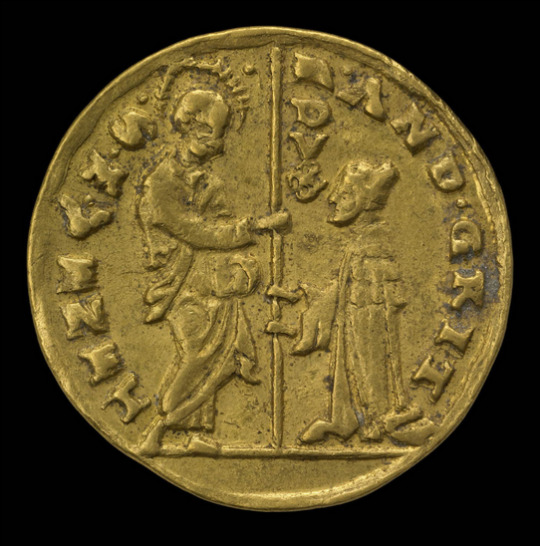
Gold ducat of Venice. Doge Andrea Gritti, Italy, 1523-38 (x)
This was the European gold trade coin, containing around 3.5 grams (0.11 troy ounces) of 98.6% fine gold, during the late medieval and early modern period. The name derives from ducatus, the Latin form of the title of the Doge of Venice, whre the ducat was first issued 1284. Called the ducado, it was worth less than a doubloon, about 10-11 silver reales, and was known to the British seaman as a ducat. The coin was copied throughout mainland Europe, and coins of the ducat standard were struck in several European countries up to the 20th century.
Gold doubloon (doblôn)

Spanish 4-doubloon, or doubloon of 8 escudos, stamped as minted in Mexico city mint in 1798 (x)
This was an early Spanish gold coin, worth approximately $4 (four Spanish dollars) or 32 reales, and weighing 6.766 grams (0.218 troy ounce) of 22-karat gold (or 0.917 fine; hence 6.2 g fine gold). The name originally applying to the gold excelente of Ferdinand and Isabella. It was later transferred to the two escudo coin issued by Spain and the Spanish colonies in the Americas. It was the largest Spanish gold coin, weighing slightly less than an ounce of gold, and originates from the Latin word duplus, or double. A doubloon was worth about seven weeks wages to a sailor.
#naval history#general history#coins#reales#piece of eight#doubloon#ducat#medieval seafaring#age of discovery#age of sail#age of steam
208 notes
·
View notes
Text
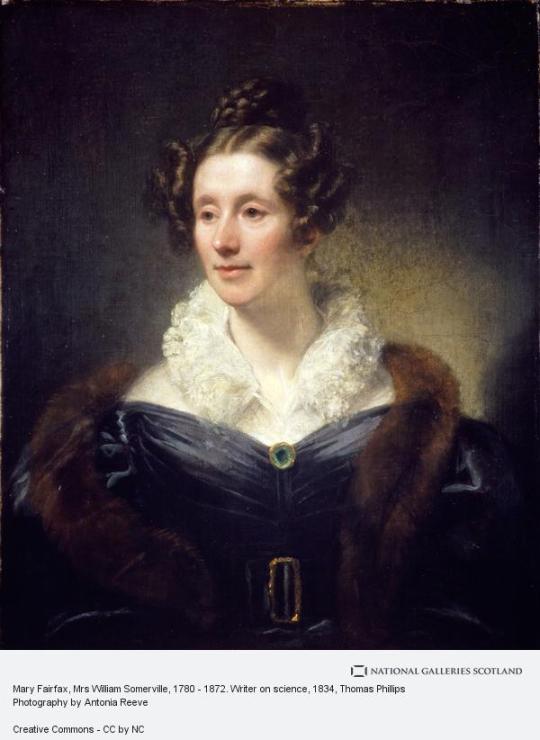
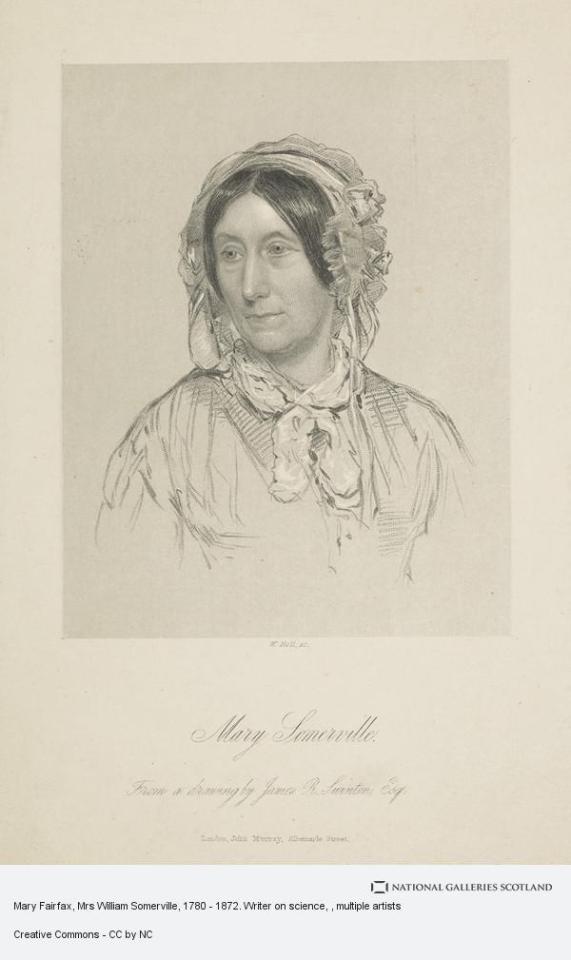
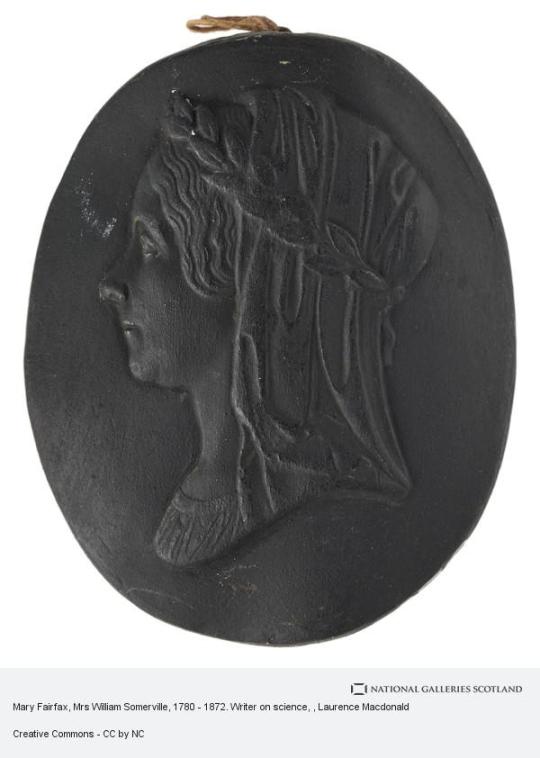
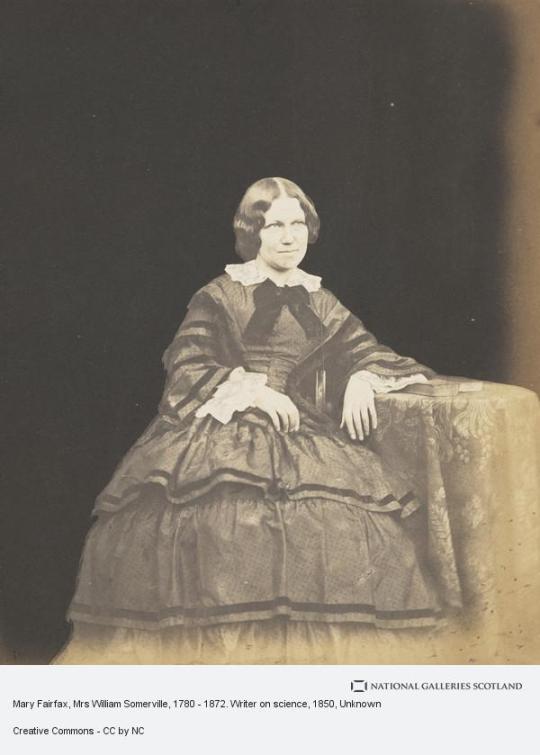
On December 26th 1780 Mathematician and scientist,Mary Somerville was born in Jedburgh.
Before Mary Sommerville came around, the word "scientist" didn't even exist!!
Born as Mary Fairfax wasrelated to several prominent Scottish houses through her mother, Margaret Charters. The family moved to Burntisland when Mary was still a child, probably due to the navy connection, her father was William George Fairfax, rose to be a Vice Admiral in the Navy.
What makes Mary's later feats all the more remarkable is that when her father returned from the sea, he discovered 8- or 9-year-old Mary could neither read nor do simple sums. By this time I assume he father had started rising through the ranks as he could afford to send her to a boarding school, Miss Primrose's School in Musselburgh.
Miss Primrose was not a good experience for Mary and she was sent home in just a year. She began to educate herself, taking music and painting lessons, instructions in handwriting and arithmetic. She learned to read French, Latin, and Greek largely on her own. At age 15, Mary noticed some algebraic formulas used as decoration in a fashion magazine, and on her own she began to study algebra to make sense of them. She surreptitiously obtained a copy of Euclid's "Elements of Geometry" over her parents' opposition. In 1804 Mary Fairfax married—under pressure from family—her cousin, Captain Samuel Greig, a Russian navy officer who lived in London. They had two sons, only one of whom survived to adulthood. Samuel also opposed Mary's studying mathematics and science, but after his death in 1807 she found herself with the opportunity and financial resources to pursue her mathematical interests.
She returned to Scotland with her surviving son and began to study astronomy and mathematics seriously. On the advice of William Wallace, a mathematics teacher at a military college, she acquired a library of books on maths and began solving math problems posed by a mathematics journal, in 1811 winning a medal for a solution she submitted.
She married Dr. William Somerville in 1812, another cousin. Somerville was the head of the army medical department in London and he warmly supported her study, writing, and contact with scientists the family moved to London in 1816 where their social circle included the leading scientific and literary lights of the day, including Babbage and the Herschel Brothers
Mary began publishing her work and was winning acclaim across Europe, so much so she was awarded a pension by the Prime Minister Robert Peel in 1834. Scottish scientist David Brewster said of her she was "certainly the most extraordinary woman in Europe - a mathematician of the very first rank with all the gentleness of a woman".
William Somerville’s health deteriorated and in 1838 the couple moved to Naples, Italy where she stayed for almost all of the remainder of her life, working and publishing.
In 1848, Mary Somerville published "Physical Geography," a book which ended up being used for 50 years in schools and universities; although at the same time, it attracted a sermon against it in York Cathedral. In 1869, Mary published yet another major work, was awarded a gold medal from the The Royal Geographical Society, and was elected to the American Philosophical Society. In 1868 aged 87 she was the first person to sign
By 1871, Mary Somerville had outlived her husbands, a daughter, and all of her sons: she wrote,
"Few of my early friends now remain—I am nearly left alone."
In 1868, four years before her death aged 91, she was the first person to sign John Stuart Mill’s unsuccessful petition arguing for women’s suffrage, in her autobiography Somerville wrote that "British laws are adverse to women".
Mary Somerville died in Naples on November 29th, 1872, just short of reaching 92.. She had been working on another mathematical article at the time and regularly read about higher algebra and solved problems each day. Her daughter published "Personal Recollections of Mary Somerville" the next year, completed mostly of before her death.
There’s a wee biography on the link below delving a bit more into Mary Sommerville’s life.
http://dangerouswomenproject.org/.../mary-somerville.../
12 notes
·
View notes
Text

Piece of Salmon
Meléndez, Luis. Attributed to
Naples, Italy, 17/06/1716-Madrid, 11/07/1780
Oil on canvas
Bilbao Museum
63 notes
·
View notes
Text

Anatomical Venus — 135cm Silk Scarf
by @logandria
The Anatomical Venus is a medical and artistic marvel—a life-size wax woman created in Florence, Italy, in 1780 with dissectible, anatomically correct layers that fit together in perfect puzzle pieces. While the Venus is miraculous in her precision and artistry, it is her paradox that has enthralled audiences for centuries. She occupies the liminal space between art and medicine, science and religion, natural and artificial, macabre and sensuous, and ethereal and deeply embodied.
Like what you see? Of course you do. Now go use code TUMBLR for 10% off all purchases from @logandria's store.
8 notes
·
View notes
Text
Witch Trial Fact Sheet
(Not every individual claim has a source, but the links included will source everything said here - a lot of them have a lot of relevant stuff, so if I linked for everything it would be putting in the same links again and again).
The witch trials were a relatively small-scale affair - modern historians give a range of 30,000 to 50,000 deaths between 1560 and 1660, the witch-hunting century or 30,000-60,000 between 1430 and 1780. That sounds massive - but it's over a century (so 300-600 a year) in a Europe with a population of 100 million (if you're wondering about population growth, it was much lower in the pre-industrial world - about 10% a century, with the demographic disaster that was the Thirty Years War negating much of that). So in any given year, the percentage of the population being accused of witchcraft was ... 0.0003% to 0.0006%.
It's even starker when you consider that the trials were very unevenly spaced geographically. Of those 30,000-60,000 people killed for witchcraft, 25,000 to 30,000 of them were in the Holy Roman Empire.
Witch hunting was not a solely or even mostly Catholic phenomenon. The biggest, most famous witch trials - Trier, Fulda, Basque Country, Würzburg, Bamberg, North Berwick, Torsåker and Salem. All of them were experiencing the Reformation, while the places with the fewest witch trials were thoroughly Catholic Ireland, Spain, Portugal and Italy. And the Spanish Inquisition killed only two witches.
It was not exclusively women who were killed for witchcraft; around 10-15% of people killed for witchcraft were men.
Similarly, witch trials were not simply (and I personally don't think primarily) about religious misogyny. The witch trials of Iceland and the Baltic countries were about enforcing Christianity on areas that were still largely pagan - and in an age when men accessed learning and political power far more and more easily than women, it's no coincidence that these witch trials mostly targeted men. In many cases, it was about searching for a culprit for the miseries of the Thirty Years War (remember that the Holy Roman Empire killed more people for witchcraft than everywhere else in Europe combined?) and the Little Ice Age. In many of the German trials, it was about enforcing Catholic or Protestant orthodoxy. My own country's (England's) bloodiest witch trials were in the midst of the English Civil War.
Witch trials were not a medieval phenomenon - large witch trials only began in 1430 and the "witch-hunting century" was 1560 to 1660, and the middle ages are generally agreed to have ended between 1450 and 1500.
Not everyone believed in witchcraft even at the time; both the Malleus Maleficarum and Daemonolgie devoted their opening sections to arguing that witchcraft existed - why would they have done this unless there were numerous, vocal or well-established people saying it didn't? And take the Malleus' word for it; "some curates of souls and preachers of the Word of God feel no shame at claiming and affirming in their sermons to the congregation that sorceresses do not exist." And we even have De Praestigiis Daemonum (1563) and The Discoverie of Witchcraft (1584) making the case for the unreality of magic.
The Malleus Maleficarum was not an official Catholic manual at any time; when Heinrich Kramer and Jacob Sprenger submitted it to the University of Cologne theology faculty for approval, they rejected it for promoting torture and teaching erroneous theology. Its use was almost entirely by secular courts.
Burning was not universal - in Britain and the American colonies, witches were hanged. As Daemonologie says, "[the execution of witches] is commonly used by fire, but that is an indifferent thing to be used in every country, according to the law and custom thereof."
Midwives were not more likely to be accused - in fact, they were more likely to be accusers.
Even at the height of the witch trials, some occult practices were widely accepted. In the words of Daemonologie "... diverse Christian princes and magistrates, severe punishers of witches, will not only oversee magicians to live within their dominions, but even sometimes delight to see them prove some of their practices." No less a figure than Thomas Aquinas approved of astrology and had some sympathy for alchemy and divination, and there was a sharp line drawn between "natural magic" such as astrology that called upon powers inherent in creation and was therefore morally neutral and the immoral "unnatural magic" of witches, drawing on the devil.
If you've enjoyed this, you can listen to a performance of Daemonologie, complete with definitions of obsolete and Scottish dialect words, here. (If you're wondering how a treatise can be performed, the book is framed as the dialogue of two characters).
10 notes
·
View notes
Photo
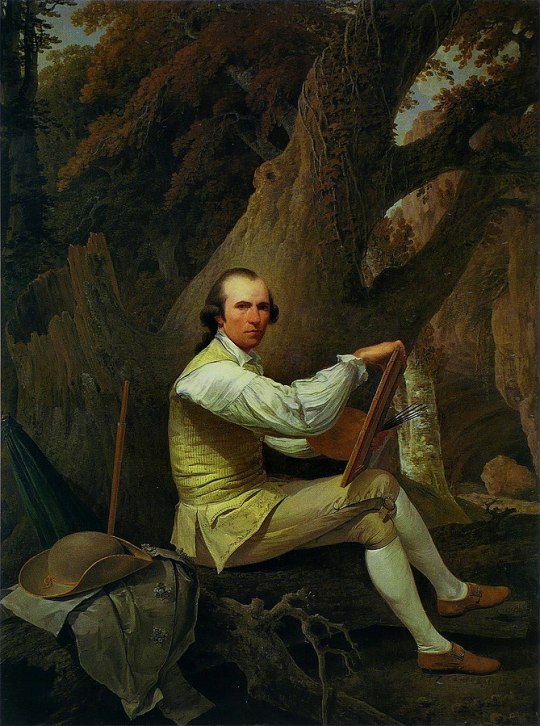
Jacob More - Self portrait - 1783
Jacob More (1740–1793) was a Scottish landscape painter.
Jacob More was born in 1740 in Edinburgh. He studied landscape and decorative painting with James Norie's firm. He took the paintings of Gaspard Dughet and Claude Lorrain as his models.
By 1773 More had settled in Italy, and spent the rest of his life there; but he exhibited Italian landscapes at the Royal Academy in London in the 1780s.
In 1787 he was visited by Goethe, who considered his work 'admirably thought out'.
In 1791 he moved to Rome. In Italy he rivalled Jacob Philipp Hackert; and he befriended Allan Ramsay (1713-1784). In Rome he enjoyed a high reputation, and was commissioned to design a garden for the Villa Borghese in the Scottish landscape style.
13 notes
·
View notes
Text
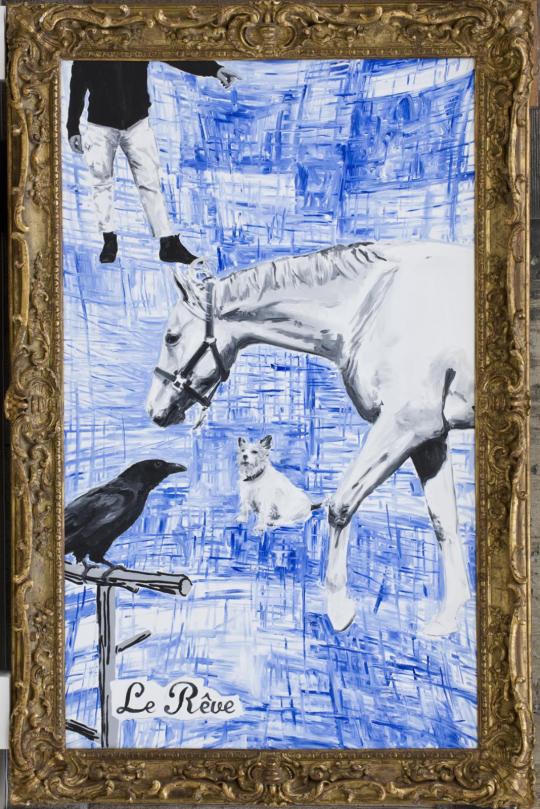
Troels Wörsel (Nov. 10, 1950 - 2018) was a Danish conceptual artist who lived abroad since 1979 - first in Germany, then in Italy. Wörsel always explored the balance between perception and representation in art - perhaps inspired by Wittgenstein and other philosophers he admired.
His work is found at all large Danish museums and quite a few select foreign ones, including MoMA, Centre Pompidou in Paris ,Moderna Museet Stockholm, Kiasma in Helsinki, and Nasjonalmuseet Oslo.
Above: Le Rêve, 2011 - Acrylic on canvas, Rococo frame in Louis XV-style from 1780 in gilded oak (SMK)
#art#danish artist#troels wörsel#2010s#conceptual art#smk#smkmuseum#statens museum for kunst#moma#centre pompidou#moderna museet#kiasma helsinki#nasjonalmuseet#le reve#acrylic on canvas#rococo frame#postmodern art
34 notes
·
View notes
Text

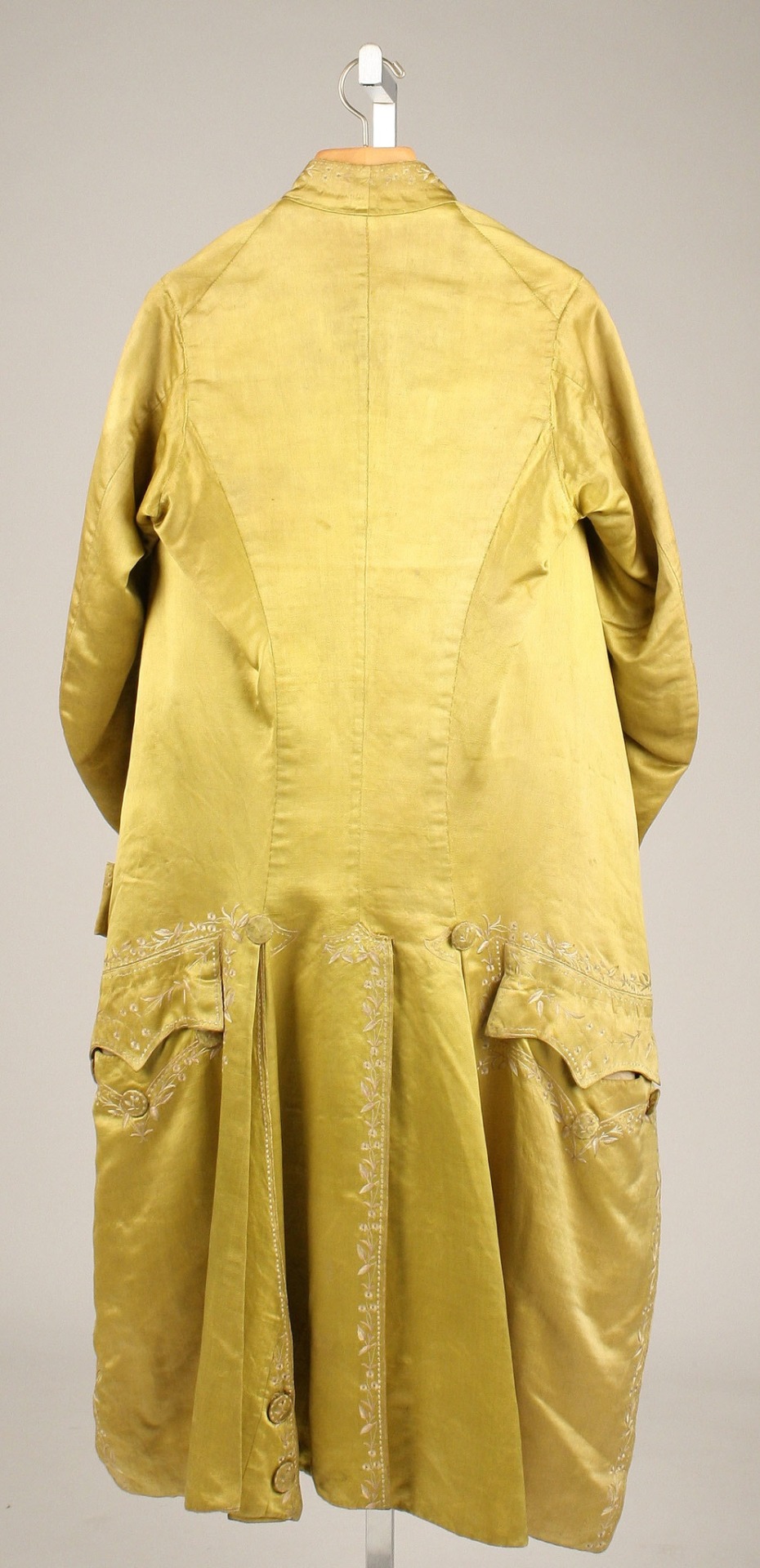
Yellow Silk Suit, 1770-1780, Italian.
Met Museum.
#met museum#18th century#silk#yellow#menswear#extant garments#italy#Italian#european#europe#suit#1770s#1780s#1770s Italy#1780s Italy#1770s suit#1770s menswear#1771#1772#1773#1774#1775#1776#1777#1778#1779#1780#1770s extant garment
7 notes
·
View notes
Photo

☀️Cuando la luz encuentra el camino correcto / When light finds the correct path - 📌Con el juego del “chiaroscuro” nos vamos, desde el Salón del trono del Palacio Real de Madrid, a la Península Itálica. ¿Y por qué?…la respuesta es sencilla. Conservando prácticamente el cien por cien de su decoración, original, este espacio fue pensado por italianos, una preferencia estricta de Carlos III en su reinado. Consolas, espejos, dosel y trono fueron pensados por G. B. Natali por encargo del Conde Gazzola. Modelos parecidos pueden encontrarse en el norte de Italia. Por otro lado, también la colgadura fue pensada por Natali y realizada, como no, en Génova. Venecia traería en 1780 estas magníficas lamparas y como no…(un poco antes) Tiepolo. Dicho pintor se encargaría del conjunto alegórico de la bóveda. Solo Carlos IV cambiaria de elección, confiando en los relojes de esta sala a franceses, y su hijo Fernando VII en la alfombra a españoles; la madrileña Real fábrica de Reales tapices la realizaría. Nunca algo tan cosmopolita fue tan espléndido, ¿no creéis? - 🇬🇧 With the visual trick of "chiaroscuro" we go, from the throne room of the Royal Palace of Madrid, to the Italian Peninsula. Why?... the answer is simple. Conserving practically 100% of its original decoration, this space was designed by Italians, a strict preference of Carlos III during his reign. Consoles, mirrors, canopy and throne were designed by G. B. Natali commissioned by Count Gazzola. Similar models can be found in northern Italy. On the other hand, the hanging velvet wall was also designed by Natali and made, of course, in Genoa. Venice would bring these magnificent lamps in 1780 and of course… (a little earlier) Tiepolo. This painter would be in charge of the allegorical set of the vault. Only Carlos IV would change his choice, trusting the clocks in this room to Frenchmen, and his son Fernando VII's on the carpet to Spaniards; Madrid's Royal Factory of Royal Tapestries would carry it out. Never has something so cosmopolitan been so splendid, don't you think? (en Palacio Real De Madrid) https://www.instagram.com/p/CjD6_3mIMLF/?igshid=NGJjMDIxMWI=
32 notes
·
View notes
Text
haha heyyyyy jesties
this year has been rough stuff. and the problem is nothing life shattering has happened so i don’t even get to have a spectacular mental breakdown. it’s just been a lot of grind and disappointment and struggle to keep up or have any energy to do anything other than the bare minimum. to everyone who reached out to me with love or kindness or memes and waited weeks or more for a response i love you. and i’m so sorry for my total absence of personhood. i’ve never gotten a dm even if it’s just a silly post and an “i thought of you” that i didn’t like. and your patience with me is appreciated more than you know.
i have some stuff i want to work on. some hobbies i want to pick up again. some friendships i want to recultivate. some pieces of my life i want to try to rekindle. i used to have so much creative energy and impulse. did you know i used to make zines? i fuckin loved making zines. the tactile experience of cutting up thick paper and punching holes and using thread to bind em and filling it with vague thoughts and little collages and splashes of acrylic paint. that shit ruled. about a month ago i tried making one for the first time in years. i cut up some old paper and dusted off the ol' hole punch. this time instead of my usual embroidery thread i used necklace chain to bind it. i was proud of that idea. when it came time to put stuff in it i choked. i had no creative thought. i forced myself to cover the first page with orange and yellow crayola markers. but that was it. i had nothing other than that. just hasty sloppy color thoughtlessly and restlessly thrown down. a dull background promised to a more interesting foreground that never came.
that shit did not rule.
in 1883 in pecos texas the first recorded rodeo takes place. in 2001 rob smets attends the PBR world finals in jeans and a sports jersey bearing sponsor logos. in 1780 joseph grimaldi makes his stage debut at 2 years old at london’s famed drury lane. in the many, many years before any white person ever laid eyes on it, a man in what you’d now call northern arizona paints his body in black and white stripes and puts corn husks in his hair. in 1557 ivan the terrible acts as pallbearer to a man who walked naked in the streets of moscow, even in the dead of winter. 1568 the gelosi acting company coalesces in italy to perform the hot new style of live improv entertainment. in 2017 the ringling bro’s circus performs its last show, 146 years after the titular brothers first formed it. all of these moments (and more!) live in my head rolling around like marbles and one day i’ll tell you all why.
i’ve been on mood stabilizers for so long it’s hard for me to tell if this has just been a really long depressive swing or if this is just how i am now. if this is just what getting older is like. i don’t really think it is. i am like 90% sure this will not last. but the two questions that follow are always 1. how do i get out of it, and 2. what if it is tho xD?
i recently went down to southeastern ohio to visit my family. went up the mountain at 1 am saturday night to help my gramma grab the 8 year old boy she’s been helping to take care of from his strung out mother. the next day i saw my various other relations, aunts and cousins however many times removed. i hung out with my second cousin. same age as me, with two twin girls, 4 years old. she’s a great mom. and enjoys it, too. got a decent husband with a good job. obviously i don’t know her struggles. not like we talk often. but she seemed overall pleased when she spoke about her life. i told her about my work from home job and my loving partner of 8 years and my plans for the future. she told me i was living the dream. and like. i kind of am. so why do i wake up every morning in various states of hangover (it's the mental illness)
i live in one of the cloudiest cities in these united states. my house is about 500 square feet. it’s dark at 5pm now. i already miss the sun. i want to get sunburned again. i want to be sweaty. i want to put talcum powder in my skort. i want to get through this winter without having to rub snow on my face to stave off more serious impulses. i want to check the 5 items off my to do list.
all of my want is like a song stuck in my head.
i miss that stickbug meme
i should dress up like a clown again
maybe tomorrow i’ll just lay under my weighted blanket for 5 hours
or maybe i’ll actually do something i like to do and feel good and real and human about it. who knows. only time will tell. and in the meantime. thanks if you read this <3




#hi and welcome to my bi-yearly Personal Rambling Long Post#a serious big fr thank u to those of you who are patient when i dont respond for long stretches of time. it means the world to me :o)
10 notes
·
View notes
Note
If you don't mind answering, what exactly makes something macaroni?
A Classical Dictionary of the Vulgar Tongue (1785) defines macaroni as follows:
An Italian paste made of flour and eggs; also a fop, which name arose from a club, called the maccaroni club, instituted by some of the most; dressy travelled gentlemen about town, who led the fashions, whence a man foppishly dressed, was supposed a member of that club, and by contraction stiled a maccaroni.
To put it simply a macaroni was a fop. That is a man who is too interested in fashion. Because interest in fashion was considered a frivolous female trait men who were "foppishly dressed" were often ridiculed for their gender nonconformity. The Natural History of a Macaroni describes the macaroni as follows:
There has within these few years past arrived from France and Italy a very strange animal, of the doubtful gender, in shape somewhat between a man and monkey, which has generated so much within that time, that they form at present no inconsiderable groupe in most of the public circles about town.
Its natural height is somewhat inferior to the ordinary size of men, though by the artificial height of their heels, they in general reach that standard; the face is quite effeminate, but sometimes distinguished by a little hair growing on it like a beard; the fore legs, or arms, are disproportionably long, the hind legs of a slender make.
Its dress is neither in the habit of a man or woman, but peculiar to itself, and varying with the day; at present it is principally discovered by an Indian flesh-coloured cloth, or silk, clasped all over with broad shining steel, and buttoned at the neck with a large black collar;
~ Walker’s Hibernian Magazine, July 1777, p458
The term macaroni really just means effeminate if someone or something was perceived as effeminate it was macaroni.
However as the term was predominantly used in the 1770s and 1780s it's associated with the fashion from those decades. So while there isn't strict rules dictating what is and isn't macaroni there are certainly some key aspects to the fashion that come up a lot in satire.
The Hair
Probably the most iconic aspect of macaroni fashion was the height of the hair. This was mocked in the satirical print What is this my son Tom. However in reality the hair was not worn that tall. Compare the caricature to Richard Cosway's self-portrait in which he is depicted wearing the fashionable style.


[Left: What is this my son Tom, print, c.1774, published by Sayer & Bennett, via The British Museum.
Right: Self-Portrait, Ivory, c.1770–75, by Richard Cosway, via The Met.]
The Suit
Menswear of the period consisted of the same basic elements; shirt, stockings, breeches, waistcoat and coat. At a time when English menswear was characterised by plain monochrome broadcloth macaroni fashion was disguised by the fabric, cut, colour and trimmings of the suit. Fashionable were the tightly cut French style suits known as habit à la française. Popular were brocaded and embroidered silks and velvets, sometimes further embellished with metallic sequins, simulated gemstones and raised metallic threads. In contrast to the black suit worn by many Englishmen, macaroni wore pastels, pea-green, pink, purple, red and deep orange.

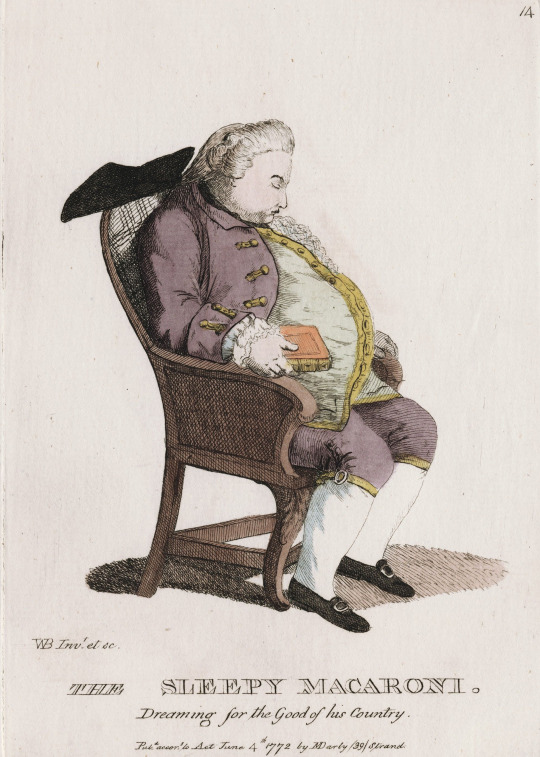
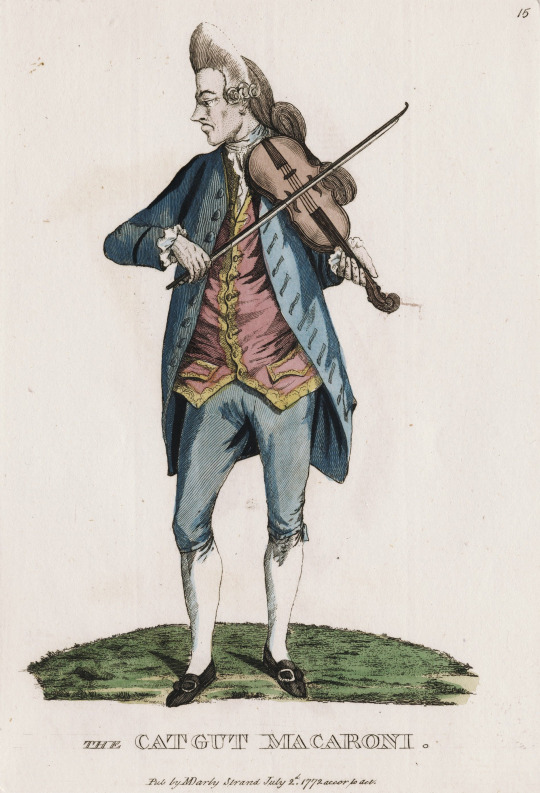
[Left: The Illiterate Macaroni, print, c.1772, by Matthew Darly, via Lewis Walpole Library.
Middle: The Sleepy Macaroni, print, c.1772, by Matthew Darly, via Lewis Walpole Library.
Right: The Catgut Macaroni, print, c.1772, by Matthew Darly, via Lewis Walpole Library.]
The Accessories
But a macaroni's ensemble was not done without accessories. Some examples of popular accessories include red heeled shoes, shoe strings, dress swords, canes, nosegays and muffs.

[Such Things Are, watercolour, c.1787, by Captain Mercer, via Lewis Walpole Library.]
If you want to learn more about macaroni I highly recommend reading Pretty Gentleman by Peter McNeil.
67 notes
·
View notes
Text
Beautiful Ornanments

Ann Bolton Moore
Artist: Boudon, David
1795
Savannah Georgia United States of America
Description:
SITTER: Though the backboard is inscribed “Mrs. Susanna Moore / Savannah Georgia” through research we determined that this is not the sitter. Two other related miniatures exist in a private collection. One of these is Mrs. Susannah Moore (1748-1810), an elderly widow. The second is of her son John Mauve Moore . By process of elimination, we determined that this third miniature from the group is John’s wife and Susannah’s daughter-in-law, Ann (Bolton) Moore (b. 1773) .
Ann Bolton was the oldest child of John and Eleanor (Dougherty) Bolton, of Kent County, Maryland. Records of Chester Parish in Kent County list the marriage of Ann’s parents and the birth of Ann and her five siblings: John (b. 1774), Robert (b. 1776), Edwin (b. 1779), Mary (1780), and Curtis (1783). In 1791, Ann married a distant cousin, John Mauve Moore of Savannah and moved to that city. She had one child who died young. The couple apparently lived with John’s mother, Susannah Moore, a wealthy widow. John died while traveling north in 1797. Susannah continued to support her daughter-in-law until her own death in 1802. Susannah’s will lists several large bequests of property to Ann. These include the house in Oglethorpe Square, near those of her siblings and several Bolton cousins.
ARTIST: David Boudon was born (1748-1816?) in Geneva Switzerland. At the age of twelve he was apprenticed to the Genevan copperplate engraver Jean-Daniel Dupre. By 1780 he was also working in metalpoint, a technique where a thin rod of metal is drawn across a surface to leave a line. There is some evidence to suggest that Boudon moved from Geneva to Italy sometime after 1786. In 1794 he emigrated to America, working first in Charleston and Savannah. His peripatetic career carried him to New York, Philadelphia, Alexandria, Virginia, Raleigh and Fayetteville, North Carolina, Baltimore, Washington, D.C., and Frederick Maryland. His last known location is Chillicothe, Ohio,
Boudon is known primarily as a miniaturist. The majority of his surviving works—50 to 60 in total—are silverpoint on vellum, although he did occasionally work in watercolor on ivory. His style, with its thin color wash over a linear image, reflects his early training as an engraver. According to his own advertisements, he considered himself more as a drafstman or “limner” rather than a painter.
REFERENCES: Nancy E. Richards, “A Most Perfect Resemblance at Moderate Prices: The Miniatures of David Boudon”, Winterthur Portfolio vol. 9, (1974) 77-102.
DESCRIPTION: Miniature portrait of a young woman. Half length, facing front, the woman wears a light blue dress, with lace ruffles, and waist sash. From her waist hang a watch and a châtelaine. Three strands of beads are around her neck and large earrings on her ears. In her curled hair are sprigs of pink flowers.
Museum of Early Southern Decorative Art
20 notes
·
View notes